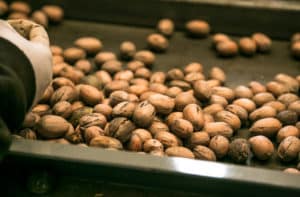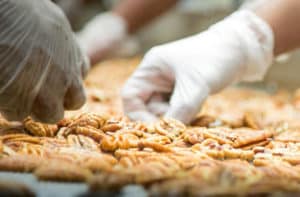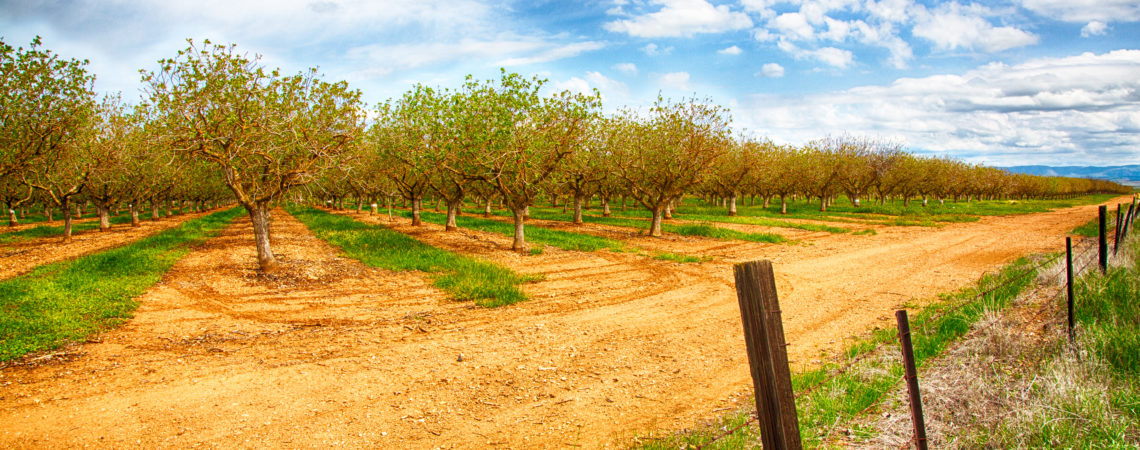A Profile of the Pecan Industry
Pecan production has steadily increased in the United States since 1925, rising from 2.2 million pounds in 1920 to between 250 and 300 million pounds today. Before 1920, pecans were “hand-shelled” by consumers — in other words, they removed the shell themselves. With the development of commercial shelling equipment, the pecan industry began to grow. In the early 1920’s, pecan processing was developed, along with equipment used for sizing, separation of faulty meats and shells, cracking, grading of meats, drying and packaging. Improvements in the area of storage life, such as temperature and humidity control, also contributed to the increasing popularity of pecans.
Pecan production in the United States
To Shell or Not to Shell
Since 1948 more than 80% of the pecans sold have been “shelled” (the shell has been removed). Some shelling plants operate year-round. Others operate on a seasonal basis, most commonly the fall months.
Large pecan plants can have as many as 14 cracking machines with a capacity of 150,000 pounds a day and 30 million pounds each season. Plants usually have a cold storage facility, some capable of holding several million pounds of shelled and unshelled nuts.
 The shelling process reduces a pecan’s weight by 50 to 65 percent and its volume approximately by half. To keep the pecan meat from shattering, the nuts are moistened or “conditioned” before cracking. There are two methods used to accomplish this. The cold water method soaks the pecans in chlorinated water for as long as eight hours. The pecans are then drained for 16 to 24 hours in sacks, vats or barrels in preparation for cracking (within the next 24-hour period). With the steam pressure method, pecans are exposed to hot water or steam pressure for six to eight minutes, then cooled and held for 30 to 60 minutes. The steam pressure method is faster, but can cause discoloration of the pecan kernels.
The shelling process reduces a pecan’s weight by 50 to 65 percent and its volume approximately by half. To keep the pecan meat from shattering, the nuts are moistened or “conditioned” before cracking. There are two methods used to accomplish this. The cold water method soaks the pecans in chlorinated water for as long as eight hours. The pecans are then drained for 16 to 24 hours in sacks, vats or barrels in preparation for cracking (within the next 24-hour period). With the steam pressure method, pecans are exposed to hot water or steam pressure for six to eight minutes, then cooled and held for 30 to 60 minutes. The steam pressure method is faster, but can cause discoloration of the pecan kernels.
The pecans are cracked by a machine that applies force to both ends of each nut. The cracked pecans are then placed on a conveyer, where they are moved to the sheller machines. Meats and shells are separated by a series of shaker screens. Shelled pecans are then separated into grades — the meats pass over rapidly vibrating machines with holes of many different sizes (for example, halves come in eight sizes, based on the number per pound).
 Once shelled, anywhere from 7 to 9 percent of the pecan meat is moisture. For quality purposes, moisture is reduced to 4 percent (or lower) by rapidly circulating dry air through the pecan meats.
Once shelled, anywhere from 7 to 9 percent of the pecan meat is moisture. For quality purposes, moisture is reduced to 4 percent (or lower) by rapidly circulating dry air through the pecan meats.
In-shell pecans are refrigerated as soon as possible after harvest, which is necessary to maintain freshness and avoid insect infestation (especially during the summer months). Freezing pecans from season to season is also an excellent method for storage— even at temperatures as low as -170 degrees (solid carbon dioxide), there is no seepage of oil or decrease in pecan quality.
Shelled pecans are packed in vacuum-packed cans, jars, glass, cellophane bags or poly-lined boxes to protect against factors such as humidity, oxidation, insects and light. The pecans are then stored or shipped to retail, foodservice or commercial markets.
Machinery used in shelling plants includes:
- Grading and sizing machinery equipped with screens and blowers (for removal of faulty nuts and foreign materials)
- Machines with vats or tanks to sterilize and condition pecans for shelling
- Cracking machines (also known as “crackers”) which crack the shells
- Shellers to separate shells from the pecan meat
- Screens which separate halves and broken pieces
- Dryers to remove excess moisture from meats
- Grading belts or tables for hand-picking of dried meats
- Electric eyes which sort shell and foreign matter from meat


